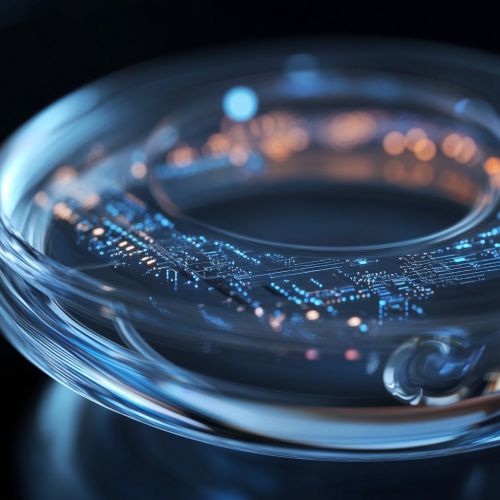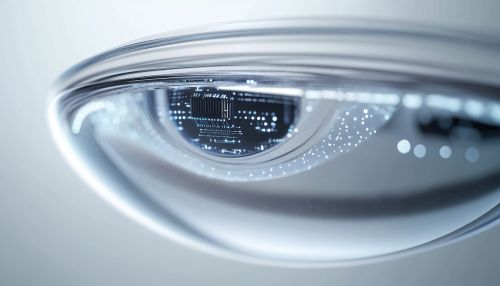Smart Contact Lens Applications
Introduction
Smart contact lenses represent an innovative convergence of wearable technology and ophthalmology, offering a range of applications that extend beyond traditional vision correction. These advanced devices integrate microelectronics and biosensors within the lens material, enabling functionalities such as health monitoring, augmented reality (AR), and enhanced visual capabilities. This article explores the various applications of smart contact lenses, delving into their technological underpinnings, potential benefits, and challenges.
Technological Foundations
Smart contact lenses are built upon several key technological components. The integration of microelectronics into the lens material is crucial for embedding sensors, circuits, and communication modules. These components are typically made from biocompatible materials to ensure safety and comfort for the wearer. Powering these devices is another challenge, often addressed through wireless power transfer or miniature batteries.
Sensors and Actuators
The core functionality of smart contact lenses is enabled by a variety of sensors and actuators. Common sensors include glucose sensors for monitoring blood sugar levels, intraocular pressure sensors for detecting glaucoma, and temperature sensors for tracking ocular health. Actuators, on the other hand, can provide feedback or adjust lens properties in response to environmental changes or user commands.
Communication and Data Processing
Smart contact lenses require robust communication systems to transmit data to external devices such as smartphones or computers. This is typically achieved through Bluetooth or near-field communication (NFC). Data processing can occur on the lens itself through integrated microprocessors or be offloaded to external devices for more complex analyses.


Health Monitoring Applications
One of the most promising applications of smart contact lenses is in the field of health monitoring. These lenses can provide continuous, non-invasive monitoring of various physiological parameters, offering significant advantages over traditional methods.
Glucose Monitoring
For individuals with diabetes, continuous glucose monitoring is essential. Smart contact lenses equipped with glucose sensors can measure glucose levels in tear fluid, providing real-time data without the need for frequent blood samples. This application not only improves patient comfort but also enables better management of blood sugar levels.
Intraocular Pressure Monitoring
Monitoring intraocular pressure is critical for patients with or at risk of glaucoma. Smart contact lenses with pressure sensors can continuously track pressure changes within the eye, allowing for early detection and intervention. This capability can significantly reduce the risk of vision loss associated with glaucoma.
Ocular Health and Disease Detection
Beyond specific conditions, smart contact lenses can monitor general ocular health. Sensors can detect changes in tear composition, temperature, and other indicators of eye health, potentially identifying early signs of diseases such as dry eye syndrome or conjunctivitis.
Augmented Reality and Visual Enhancement
Smart contact lenses also hold potential in the realm of augmented reality and visual enhancement. By overlaying digital information onto the user's field of view, these lenses can transform the way we interact with our environment.
Augmented Reality Applications
Incorporating AR capabilities into contact lenses allows users to access information hands-free, directly within their line of sight. This can be particularly useful in fields such as surgery, where surgeons can view patient data and imaging without looking away from the operative field. Similarly, in industrial settings, workers can receive real-time instructions and alerts, enhancing productivity and safety.
Visual Enhancement for Low Vision
For individuals with low vision, smart contact lenses can enhance visual capabilities by adjusting contrast, brightness, and magnification. These lenses can also incorporate night vision or thermal imaging technologies, providing improved vision in low-light conditions.
Challenges and Considerations
Despite their potential, smart contact lenses face several challenges that must be addressed before widespread adoption can occur.
Biocompatibility and Comfort
Ensuring that the materials used in smart contact lenses are biocompatible is crucial to prevent irritation or damage to the eye. Comfort is also a significant consideration, as the lenses must be worn for extended periods.
Power Supply and Energy Efficiency
Powering smart contact lenses remains a technical hurdle. Solutions such as wireless power transfer or energy harvesting from ambient light are being explored, but achieving sufficient energy efficiency without compromising functionality is challenging.
Data Privacy and Security
With the ability to collect and transmit sensitive health data, smart contact lenses raise concerns about data privacy and security. Ensuring secure data transmission and storage is essential to protect user information.
Future Prospects
The future of smart contact lenses is promising, with ongoing research and development aimed at expanding their capabilities and improving their practicality. Potential advancements include integrating artificial intelligence for predictive analytics, developing more sophisticated AR applications, and enhancing the miniaturization of components.
